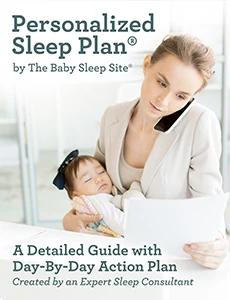 When your baby is awake a lot at night, you can become beyond exhausted. Getting your baby to sleep at night is one of the most important things you can do as a new parent. This blog post will teach you how to get your newborn to sleep at night so your entire family can get sleep!
When your baby is awake a lot at night, you can become beyond exhausted. Getting your baby to sleep at night is one of the most important things you can do as a new parent. This blog post will teach you how to get your newborn to sleep at night so your entire family can get sleep!
In This Article
Introduction to the 7 Steps to Get Your Newborn to Sleep at Night
1: Set an Appropriate Schedule and Bedtime
2: Follow a Bedtime Routine
3: Dress Your Baby Appropriately
4: Check the Sleeping Environment
5. Soothe Baby to Sleep or Teach Baby to Self-Soothe
6. Consider a Dream Feed
7. Set Realistic Expectations
Where to Find More Sleep Tips
Introduction
The old adage “sleep like a baby” implies that babies simply come out sleeping. But, that couldn’t be further from the truth! In the early days, many newborns often have day / night confusion where they are awake all night and sleep all day. That’s the opposite of what we want and why new parents are overly exhausted.
While day/night confusion will usually resolve in a few weeks, some babies will continue to wake up a lot at night. Newborns often need to eat every 2-3 hours at night so that’s one of the primary reasons babies wake at night. Babies often wake at night due to other reasons, too, though.
This article will tell you how to get your newborn to sleep at night in 7 steps.
1. Set an Appropriate Schedule and Bedtime
In my 15+ years as a sleep consultant, one of the biggest mistakes we see parents make is in setting the schedule. Most people think that the more tired you are, the easier it is to sleep. But, this is simply not true, unfortunately.
In fact, the more overtired you are, the more difficult it is to fall asleep and stay asleep.
This is because our bodies release hormones to fight fatigue and give us a “second wind.” Once we get to this point, we might feel wired and can’t settle down. This is true for babies, too, only they get overtired much quicker than adults!
It is very important to look for your baby’s sleepy cues and use appropriate wake windows. If you keep baby awake too long, you are likely to hear your baby cry and wake more. In addition, make sure newborns are fed at regular intervals.
2. Follow a Bedtime Routine
A bedtime routine is simply a set of steps you follow in a certain order so your baby knows sleep is coming soon. Since the routine is the same every time, this helps them get sleepy easier. While most babies benefit from this structure, some babies seem to need it. Your baby’s temperament will dictate how easy or hard some things are. For less adaptable babies, a consistent routine helps keep things running more smoothly.
For more information, make sure you read through our newborn bedtime routine tips.
3. Dress Your Baby Appropriately
One way how to get a newborn to sleep is to make sure they are comfortable. If your baby’s moro reflex is still strong, it will be best to swaddle your newborn. If your baby is no longer swaddled, you will likely use a sleep sack.
For some babies, especially those who are more sensitive, may benefit from a weighted sleep sack. These are especially useful when your baby could benefit from being swaddled but it’s no longer safe or they don’t like it.
Underneath the swaddle or sleep sack, you don’t want to add too many layers such that your baby overheats. Our body temperature should be cooler to get the best sleep and overheating has been linked to an increased SIDS risk. So, you might have a diaper and a onesie or sleeper underneath. You probably don’t need a onesie, sleeper, AND a sleep sack or swaddle, though, unless it’s very cold where you are.
4. Check the Sleeping Environment
Your baby’s sleeping environment can make a big difference as to whether it will be easy or hard to stay asleep. A few things to make sure your sleep environment has:
- Darkened Room – Don’t let the sunlight wake your baby prematurely and, likewise, make sure any night lights aren’t too bright!
- White Noise – Mimic the sounds of the room by playing white noise for at least 20-30 minutes or through the night. The volume should be about the sound of a running shower.
- Room Temperature – Your baby’s room should be 68 to 70 degrees Fahrenheit (or 20 to 21 degrees Celsius). Again, overheating is a SIDS risk and, in addition, we simply sleep better in cooler temperatures. This is why parents in Nordic countries have their babies nap outside!
- Crib Toys – Some families also use mobiles or other crib toys. These can help soothe baby to sleep by playing lullabies or giving baby something to look at as they drift off.
As with many things, every baby has different preferences so you will want to set up your baby’s sleep environment in a way that works for you and for them. You might need to experiment.
5. Soothe Baby to Sleep or Teach Baby to Self-Soothe
Once you’ve set up your baby for success by following Steps 1 through 4, it’s time to have your baby fall asleep. Depending on the age of your baby and/or your situation, you will either soothe your baby all the way to sleep or teach your baby to self-soothe to sleep.
If you have a newborn, you might be interested in the SNOO Smart Bassinet. It has a built-in swaddle and white noise. In addition, it will start rocking when it detects the baby starts crying.
Other ways of soothing babies to sleep include the following:
- Feeding baby to sleep
- Rocking baby to sleep
- Bouncing baby to sleep
- Co-sleeping
- Patting
- Holding baby on your chest or in your arms
Obviously, all babies have different preferences for what is soothing to them. Finding the “right” way for your baby typically comes with experimentation and time. However, over time, these soothing methods can become sleep problems. Once your baby starts having more distinct sleep cycles, you may find you are soothing your baby back to sleep every 1-2 hours all night.
If your baby is waking up all night, you might want to try helping your baby learn to self-soothe to sleep. When we teach a baby to self-soothe, we put them down awake after their bedtime routine and let them fall asleep the rest of the way. If they can do this, this means they are more likely to fall BACK to sleep on their own between sleep cycles.
The main challenge with babies self-soothing is that they often cry when you put them down especially after the 4 month sleep regression. That’s why some babies will only sleep on your chest. This can be difficult and why many parents choose to do gentle sleep coaching or traditional sleep training such as The Ferber Method, eventually.
6. Consider a Dream Feed
Although my son was not one of them, some babies are actually “good” sleepers but they simply need a feeding at night until they are older. For these babies, a dream feed can be a great solution! With a dream feed, essentially you are giving your baby a feeding right before YOU go to bed usually around 10 to 11 PM. Click the link earlier in this paragraph for more tips on implementing a dream feed.
7. Set Realistic Expectations
When you are researching how to get your newborn to sleep, you will find some people have stories where their baby started sleeping through the night in two or three nights. Or, there are books like 12 Hours By 12 Weeks which is supposed to help you get your baby sleeping through the night by 12 weeks old. While this can happen, it is not common and sometimes not healthy. Try not to compare your baby’s sleep with others, and keep in mind that there are a multitude of factors that will determine when your baby will sleep through the night.
Every baby is different and here are the things that influence when your baby will sleep at night in my experience:
- Age
- Temperament
- Medical issues such as reflux
- Breastfeeding or Formula-Feeding
- Big or Small Feedings (so stomach size)
- Sleep Regressions
- Growth spurts
- Teething
How to Get Newborn to Sleep: More Sleep Tips for Your Newborn
In the past 15+ years, we’ve written over 500 blog posts to help your baby sleep. Here are a few more resources you might be interested in:
- Can You Teach Baby to Sleep Through Noise?
- How to Gently Transition From Co-Sleeping
- Sleep Training Newborns: How To and When
- Sleep Regressions: Ages and Everything You Need to Know to Handle Them
- 5 Ways to Help Your Child Sleep Through the Night
- 5 Reasons Your Newborn Is Crying
- Newborn Not Sleeping at Night? Here’s Why…








